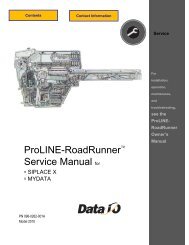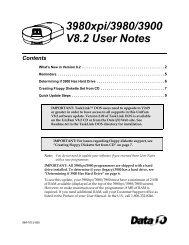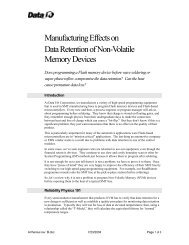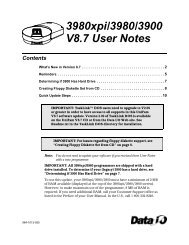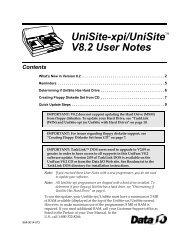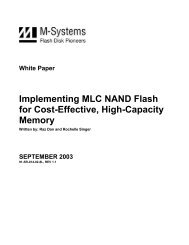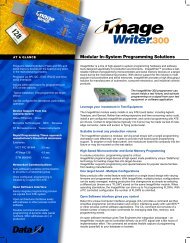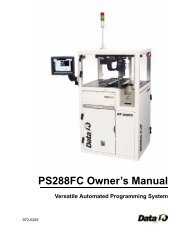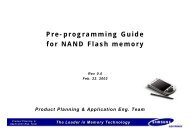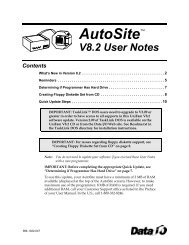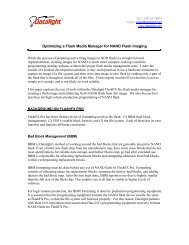3980xpi Users Manual - Data I/O Corporation
3980xpi Users Manual - Data I/O Corporation
3980xpi Users Manual - Data I/O Corporation
Create successful ePaper yourself
Turn your PDF publications into a flip-book with our unique Google optimized e-Paper software.
Commands<br />
� Compensated Vector Test (Y,N)<br />
Y enables load compensation on PLD output pins under test during vector<br />
testing, which may eliminate structured test errors when testing PLDs<br />
sensitive to output loading where many of the device's registers transition<br />
simultaneously. This test is available only for logic devices and defaults to<br />
N at powerup. It defaults to Y if you select a non-Open Collector device<br />
and defaults to N if you select an Open Collector device. This parameter<br />
can be saved/restored with the Save/Restore Configuration command.<br />
� Display Device Footnote (Y,N)<br />
Y enables the programmer to automatically display any device-specific<br />
information for the selected device. N disables automatic display and<br />
causes the programmer to display this message if there is any devicespecific<br />
information: Hit F3 or ? to view device specific<br />
message.<br />
� Abort on Empty Socket (Y,N)<br />
Y (the default) causes the programmer to abort the operation in progress<br />
when an empty socket is found. A Load operation on an empty socket does<br />
not change RAM and no checksum is reported. N disables this option.<br />
� RAM Device Selection (Y,N)<br />
Selecting Y causes the programmer to load default (Algorithm Type D)<br />
algorithms into RAM. (This feature is limited to programmers with 8MB of<br />
RAM.) N disables this option and frees up any RAM used by the option.<br />
When you select a device after you power up with this option enabled, the<br />
programmer loads the algorithms from the Algorithm disk that is inserted<br />
in the disk drive and displays the following message: Loading device<br />
algorithm file into user RAM. You are prompted to insert a different<br />
disk if you select a device whose algorithm is not yet loaded into RAM.<br />
Serial I/O Port Configuration<br />
More Commands / Configure System / Edit / Serial I/O<br />
Use the Edit Serial I/O Port Configuration command to specify the<br />
communications parameters for the programmer's two serial ports.<br />
Use this command when you connect equipment to the programmer's Terminal<br />
and Remote ports so they can be compatible with your terminal or host<br />
computer. To save the settings of the two ports for use in a future session,<br />
save them in a configuration file.<br />
A change in the serial port parameters does not become effective until you<br />
press ENTER. If terminal settings are changed, a message prompts you to press<br />
ENTER again after you alter your terminal to match the new settings. Output to<br />
the terminal is suspended until you press ENTER the second time.<br />
The parameters and their settings are described below.<br />
� Baud Rate<br />
Specifies the baud rate for both the Terminal and Remote ports. Press<br />
SPACE to cycle through the baud rates supported by the programmer. The<br />
programmer supports the following baud rates: 50, 75, 110, 134.5, 150,<br />
200, 300, 600, 1050, 1200, 1800, 2000, 2400, 4800, 7200, 9600, and<br />
19.2K baud (and 115.2K baud with HiTerm).<br />
<strong>3980xpi</strong>/3980/3900/2900 User <strong>Manual</strong> 4-25




